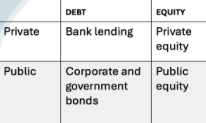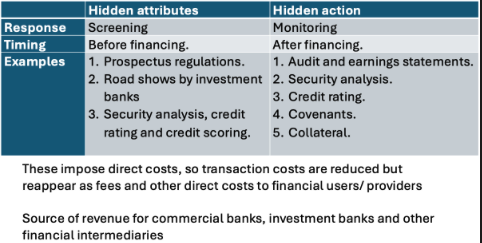Y2 S1 Economics of the Financial System
1/23
There's no tags or description
Looks like no tags are added yet.
Name | Mastery | Learn | Test | Matching | Spaced |
|---|
No study sessions yet.
24 Terms
What is direct finance? When and why does it become more imporatant?
Direct finance is when borrowers borrow funds directly from lenders in financial markets by selling them securities (like stocks or bonds).
This becomes more important as countries become richer. Due to:
Financial markets are more developed – richer countries have stronger stock and bond markets, making it easier for firms to raise money directly.
More information transparency – better accounting, regulation, and technology reduce the need for intermediaries to assess borrower risk.
Larger and more sophisticated firms – big firms can issue securities directly instead of relying on bank loans.
Wealthier investors – more people have savings to invest directly in markets rather than through banks.
What is indirect finance?
Indirect finance is when borrowers get funds through financial intermediaries (like banks), which collect funds from savers and then lend to borrowers.
What is equity?
Equity is a residual claim on the firm.
- The payments to equity are not fixed
- Equity is also a share in ownership
- Equity is also a share in ownership
- Can be public or private
What is debt?
Debt is borrowing that must be repaid on a fixed schedule.
Interest is paid as agreed between borrower and lender.
Debt servicing—paying interest and repaying the principal—has a prior claim, meaning it’s paid before equity holders.
Debt can be public (like government bonds) or private (like bank loans).
What are the most to least important sources of investment finance?
1. Bank lending
2. Corporate bonds
3. Private equity e.g. venture capital investment, private equity funds
4. Public equity

What are transaction costs?
Definition: the costs to buyers and sellers of conducting an economic exchange.
Two categories:
Direct = the time, effort and expense of searching for products and services and for reaching agreements to trade and the contractual costs of enforcing these agreements; and
Indirect = the economic inefficiencies (or frictions) of exchange, resulting from asymmetric information (leading to hidden attributes, adverse selection and moral hazard)
and also (not a focus in this module) contractual incompleteness (the costs arising because contracts cannot be fully enforced).
Explain Asymmetric information 1 (hidden attributes)
One party knows more about their qualities or characteristics than the other (e.g. borrower knows their true risk, lender doesn’t).
Leads to problems before a transaction happens.
Explain Asymmetric information 2 (adverse selection)
Occurs before a transaction, due to hidden attributes.
Lenders can’t tell risky from safe borrowers.
They charge an average interest rate, which drives away low-risk borrowers and attracts high-risk ones.
Result: more risky borrowers remain — this is adverse selection.
Explain Asymmetric information 3 (hidden action and agency costs)
After a contract, one party’s actions can’t be fully observed.
This creates agency costs — the costs of monitoring or ensuring the agent acts in the principal’s best interest.
Explain Asymmetric information 4 (moral hazard)
A form of hidden action occurring after a transaction.
People take more risks when they don’t bear the full consequences (e.g. managers gamble with company money or banks take risks due to bailouts).
Example: bank moral hazard — safety nets make banks take bigger risks.
What actions may be taken to reduce indirect transaction costs?
